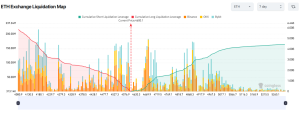In brief
CoinShares has filed for a Solana Staking ETF on Nasdaq, joining BlackRock, Fidelity, and others in adding staking features to their crypto ETF offerings.
The Rex-Osprey Solana + Staking ETF already launched with $137 million AUM, showing early demand despite Solana funds representing only 8.7% of Ethereum ETF assets.
Staking ETFs offer 7-8% yields but face execution risks around redemptions, as unstaking SOL can take 2-3 days while ETF settlements require same-day liquidity.
Digital asset manager CoinShares has submitted an S-1 form in application for a Solana Staking ETF, which it intends to list on the Nasdaq.
According to the filing, the CoinShares Solana Staking ETF will hold SOL but also stake “a portion” of its holdings, with BitGo set to serve as the fund’s custodian and its staking partner.
CoinShares doesn’t specify the likely percentage of the fund’s holdings that will be staked, but it does acknowledge the hypothetical risk that it may “become unable to timely meet excessive redemption requests in amounts that are greater than the portion of the Trust’s SOL that remains un-staked.”
Despite this potential risk, the CoinShares Solana Staking ETF joins several similar filings in recent weeks, with the likes of BlackRock, Fidelity, Grayscale and 21Shares all applying to add staking to their existing Ethereum ETFs.
Invesco Galaxy has also filed an application for its own Solana staking ETF within the past week, while the Rex-Osprey Solana + Staking ETF launched last month after gaining automatic approval under the Investment Company Act of 1940.
The latter fund attracted $12 million in first-day inflows and currently has assets under management of $137 million, indicating considerable early demand for Solana ETFs.
The potential for growth in such funds has also been underlined by the recent successes of Ethereum ETFs, which now boast a total AUM of $27.5 billion, according to the latest CoinShares Digital Asset Fund Flows report.
The past month has seen record inflows into ETH ETFs, which grew by $5.24 billion between July 1 and August 1, according to data from Farside.
This is roughly comparable to the $5.5 billion in Bitcoin ETF inflows over the same period, whereas Solana funds grew by only $137 million, thanks to the aforementioned Rex-Osprey Solana + Staking ETF.
In total, Solana-based funds currently boast an AUM of $2.4 billion, which is only 8.7% of the equivalent total for Ethereum funds, whereas Solana’s market cap is approximately 20% of ETH’s.
However, while demand for Solana (and altcoin) ETFs is likely to rise in the coming months, some analysts don’t think the inclusion of staking will make a substantial difference.
This is the view of Bryan Armour, Morningstar’s Director of ETF & Passive Strategies, who tells Decrypt that he doesn’t expect staking alone to “meaningfully change” institutional demand.
“Staking should make ETFs more efficient because they capture yield otherwise missed out on by unstaked spot ETFs, but the main driver of performance will be the underlying cryptocurrency,” he said. “I suspect institutional demand for staked Solana ETFs will come from the desire for diversified crypto exposures, like with Bitcoin and Ethereum ETFs, in case one significantly outperforms or underperforms the others.”
However, some industry figures do believe that staking will be an added draw for institutional investors, who previously may have been turned off by the perceived difficulty of staking for themselves.
“Institutional demand for staking ETFs is rising fast as investors look for yield without the operational complexity of staking directly,” says James Harris, the Group CEO of DeFi platform Tesseract, speaking to Decrypt.
According to Harris, such products will simplify access to protocols such as Ethereum and Solana, the latter of which currently has yields of between 7% and 8%.
“It’s a natural evolution: If investors can choose between holding SOL alone or holding SOL while also earning a protocol-native yield, it’s a no-brainer that they’ll prefer the latter,” he added.
On the other hand, Harris acknowledges that staking introduces some “execution risk” on top of standard custody and counterparty risk, although in his view the reward generally justifies the added complexity.
In particular, the main execution risk involves the aforementioned difficulty of providing redemptions when most of a fund’s SOL is staked, something which Armour recognizes as the primary danger.
“Un-staking could take anywhere from hours to several days, with the average time reportedly two to three days,” he explained. “ETF redemptions settle within one day, so the ETF cannot stake the entire portfolio and expect to meet redemptions.”
Given this risk, Armour expects that most staking ETFs will ensure that enough of its holdings aren’t staked, although he also accepts that it’s possible that redemptions could exceed the liquid portion of a given fund, creating issues for the ETF and its market makers.
He said, “In this scenario, I would expect the price of the ETF to trade at a discount to its net asset value, forcing investors to sell their shares at a discount if they wanted to get out.”
Daily Debrief Newsletter
Start every day with the top news stories right now, plus original features, a podcast, videos and more.













